Generative AI is Transforming Healthcare? Key Applications and Benefits
Discover how Gen AI in Healthcare optimizes patient care. Learn how models power applications, driving benefits and tackling key challenges.
5/14/2025
artificial intelligence
14 mins
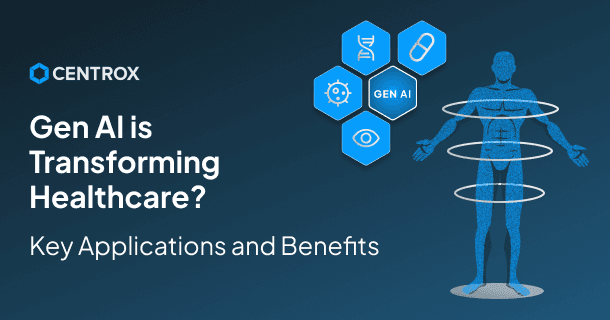
Generative AI completely disrupts the traditional setup and practices by bringing transformative advancements. These advancements are now making their way to innovate the healthcare sector and ultimately introduce convenience for life. Therefore, we can anticipate that Generative AI in healthcare will change the current world dynamics
While earlier we had to make extra efforts to get an appointment, find a reliable doctor, and commute to the hospital, and receive the required assistance, today we can get all of these from a single generative AI assistant just within a few minutes. Thus, reducing the need to wait for long hours or days for your appointment, and commuting to the respective hospital.
With our article, we will help you explore how generative AI in healthcare can enhance the overall efficiency with its applications, what its benefits could be, and the possible limitations that can be a challenge in the way of introducing safer AI-driven healthcare innovations.
Why does the healthcare sector need AI integration?
The current healthcare service facilities possess a lot of issues, but one of the core issue they holds is the limited accessibility to everyone. While healthcare is one of the primary needs for humans, a lack of access to a proper healthcare facility can cause serious inconveniences.
Also, with a growing population, we can anticipate a growing influx of patients in the hospitals, and the resources in terms of doctors, nurses, machinery, and infrastructure might not be enough to cater to the needs of this many people. Here, integrating generative AI-driven automation can resolve a major number of these challenges efficiently, if not all of them.
By introducing safe generative AI-based solutions, we can streamline the healthcare services all from a single platform. As such AI-powered solution can provide initial health support, collect the data, suggest you appropriate treatment or doctor, and even schedule an appointment for you as per your need.
The innovation of generative AI solution can introduce for healthcare solutions can be better understood in the words of Andrew Ng( Co-founder of Google Brain & Founder of DeepLearning.AI):
"AI is the new electricity—and in healthcare, it can power innovations from early disease detection to personalized treatment. The impact it will have on improving access and reducing costs is immense."
This quote highlights that generative AI can play a significant role in revolutionizing the healthcare service process, not just by enhancing accessibility, but also improving efficiency and reducing cost.
Generative AI Models and Their Application for Healthcare Problems
To ease the burden of healthcare service providers, these generative AI models can play a very significant role, particularly to enhance operational efficiency. To provide you with a better understanding, some important generative AI models are listed down with their specific application for the healthcare industry:
GPT-4 and Large Language Models (LLMs)
Generative AI models like GPT-4 and LLMs can essentially help in healthcare service applications. These models function by understanding the underlying pattern of the large dataset to generate responses that precisely address the given problem. Implementing LLMs or GPT-4 for healthcare needs can contribute to enhancing the clinical decision support, medical report generation, and can also work as your virtual health assistant.
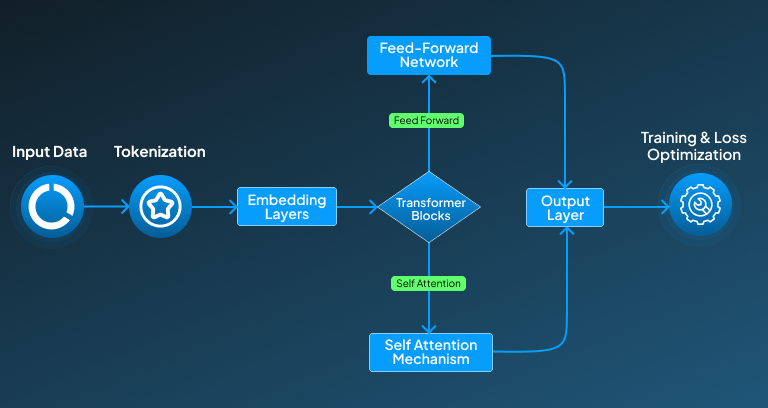
Application
GPT-4 and LLMs have a specific architecture that helps them in generating outputs that are close to how humans would respond, which makes it very helpful for applications like:
Clinical Decision Support
For applications like clinical decision support, generative AI models like GPT-4 and LLMs can deliver revolutionary advancements. The model behind clinical decision support works by being trained on vast medical data, patient records, and guidelines, it understands the complex pattern working behind it to make evidence-based responses. Such applications can be used to help the doctor in making a proper diagnosis and in providing appropriate treatment options by analyzing the symptoms and patient history.
Example: Mayo Clinic & Microsoft Azure OpenAI
Medical Report Generation
Keeping a record of medical documentation that includes prescriptions, discharge notes, radiology reports, and pathology reports is essential for tracking patient history and evaluating the health on the prescribed treatment plan. Having a generative AI-powered tool that caters to this need can be really helpful in keeping records streamlined. For applications like report generation, the LLM or GPT-4-based model takes structured or semi-structured data inputs by scanning the results and vitals to generate coherent and medically acute reports. This helps in saving the time and efforts of healthcare providers by reducing the need of doing redundant paperwork, and provides standardization.
Example: Nuance DAX (Dragon Ambient eXperience)Nuance DAX (Dragon Ambient eXperience)
Virtual Health Assistants
By having generative AI-powered virtual health assistants, we can essentially help the patient get immediate help for urgent queries. As the LLM model behind the solution of this type of world to deeply understand the provided input, it evaluates the symptoms using the medical information, and eventually generates a response for the query. This helps reduce the excessive patient load on hospitals, along with speeding up support access.
Example: Babylon Health
GANs (Generative Adversarial Networks)
Generative Adversarial Networks is another generative AI model that can have revolutionary applications for the healthcare industry. It functions by having two competing models, the generators and the discriminator. Here, the generator works to generate realistic responses, and the discriminator has to evaluate if it's actual or generated. Over time, the generator becomes well-trained to generate realistic responses which is indistinguishable by the discriminator. GANs can be implemented for healthcare applications, healthcare applications like image augmentation and anomaly detection.
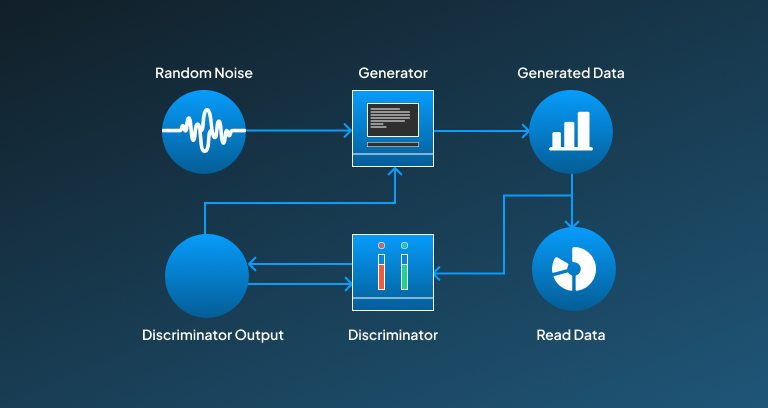
Application
GANs can be implemented for healthcare applications like medical image augmentation and anomaly detection training, which helps in improving the quality of medical scans and disease diagnosis.
Medical Imaging Augmentation
GANs can be very helpful for enhancing the training dataset for medical scans by generating highly realistic responses. The generator network in the GANs works for creating generated images, which are evaluated by the discriminator, and further used by diagnostic models as training data, especially for rare diseases for which data is limited. This application contributes to providing a quality dataset for enhancing the ability of a rare disease diagnosis model.
Example: Arterys
Anomaly Detection Training
Finding out the abnormalities in images manually can be difficult, and there is a possibility of a wrong diagnosis. Implementing a solution that uses the visuals generated by GANs for training the model to improve its accuracy for detecting the abnormalities in the provided input image can help in making an accurate diagnosis. By training on this GAN-generated data, these diagnostic tools can generalize better and provide early disease detection.
Example: PathAI
Diffusion Models
Diffusion models are a type of generative AI model that function by transforming random noise into some meaningful structured data, which could be an image or molecular structure. This process of diffusion model is inspired by a physical diffusion process, in which the model learns how to reverse the noise-adding process to recreate detailed outputs.
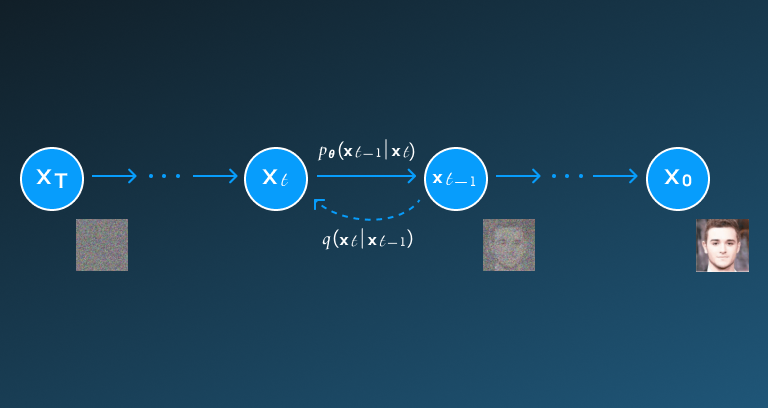
Application
Diffusion models can have a very impactful application, specifically for healthcare services; they can extend their application for drug discovery, molecular design, and synthetic biomedical imaging to strengthen model training.
Drug Discovery and Molecule Design
Creating a new drug for diseases can be a long and effort-intensive task, especially if it's being done through conventional methodologies. By using a diffusion model to learn the distribution of valid molecules, we can iteratively generate new compositions of drugs for specific diseases from random noise. This reduces the research and development time from years to months and will significantly reduce the cost spent for drug discovery.
Example: Insilico Medicine
Synthetic Biomedical Imaging
Biomedical imaging is an essential component for making the right diagnosis. By automating the process of image analysis, we introduce a more efficient procedure for diagnosis. With the diffusion model, we can refine the random noise step-by-step and convert it into detailed, realistic images by learning from real image distributions. This extends diverse data and helps the model to train on rare scenarios to improve its diagnostic accuracy.
Example: NVIDIA’s MONAI + BioNeMo
GFlowNets (Generative Flow Networks)
GFlowNets (Generative Flow Networks) is a type of generative AI model that produces diverse, high-quality outputs by sampling from complex decision spaces. Contrary to the conventional models, which only compute a single best solution, these GFlowNets can provide multiple options of solutions, making it ideal for drug discovery and finding suitable treatment paths.
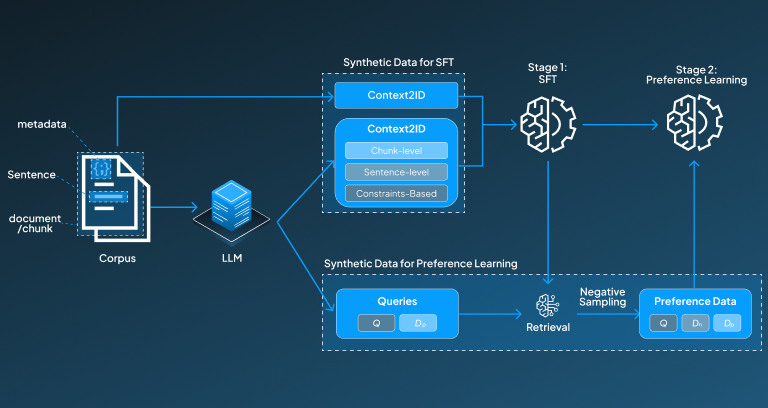
Application
GFlowNets can be implemented for applications like drug discovery exploration and for some extremely transformative applications like optimizing treatment plans.
Drug Design Exploration
Discovering a variety of potential drugs for the disease is a very detail-oriented, research-based task. By integrating GFlowNet, we can get a variety best solutions instead of getting a single best solution or option for drug composition. These integrated GFlowNets have a probabilistic model that flows over complex graphs. Such a solution can be very revolutionary for the healthcare domain in reducing the time and effort that is involved in drug discovery.
Example: Mila (Québec AI Institute)
Treatment Path Optimization
Having an appropriate treatment plan can streamline the whole treatment process and can save both the patient and healthcare provider from real-time hassle, especially in an emergency. The GFlowNet is involved in such a solution to evaluate the different treatment plans and generate multiple sequences of the best possible decision. This helps in extending a more personalized adaptive treatment plan for chronic multi-stage diseases, specifically.
Example: DeepMind Health (now part of Google Health)
AlphaFold
AlphaFold is a generative AI model that can predict the 3D structure of a protein from a sequence of amino acids. By utilizing deep learning models and evolutionary data to model sub-atomic level folding patterns. This generative AI model helps in predicting drug compositions, genetic disease research, and protein engineering, reducing the time and cost spent on laboratory analysis.

Application
The AlphaFold generative AI model can be very beneficial for applications like predicting protein and understanding genetic diseases. Below, we have explained that in detail.
Protein Structure Prediction
Finding how proteins fold is very critical to understanding the disease pattern. By implementing AlphaFold, we can predict the 3D structure using the amino acid sequence by training the model on known proteins. This eliminates the need to go through years-long lab-based protein studies for accelerating the development of targeted therapies.
Example: Genentech
Genetic Disease Understanding
Millions of people around the world are suffering from genetic diseases. Despite these large numbers, there isn't much progress in reducing their occurrence, as the research procedure is long. Using methodologies like AlphaFold, we can have a model that can understand how mutations are affecting the protein structure and eventually compromising its functionality to perform normally. This can help in identifying genetic disease causes and provide a personalized treatment plan based on the patient's DNA.
Example: EMBL-EBI
Synthetic Data Generators (Domain-Specific Models)
Synthetic Data Generators are domain-specific models that generate synthetic yet realistic data, like patient records or medical images. By being trained on such realistic data, they resemble the pattern without getting access to sensitive information. This model ensures compliance with privacy policies while training the AI model, ensuring safe AI use.

Application
By using models like a synthetic data generator, we can get healthcare applications that abide by the privacy rules and address the issue of biases in the dataset.
AI Model Training Without Privacy Risk
By training the AI model on synthetic or generated patient data that mimics the real patient data, we can ensure the AI model sticks to the compliance policies. These synthetic data generator models function to produce highly realistic fictional data for training diagnostic or treatment planning models. Involving such models, we can ensure the safe AI innovation by prioritizing data privacy.
Example: Synthea (by MITRE)
Addressing Bias in Datasets
We can use synthetic data generators to fill the gaps in the underrepresented patient population. This model's function by create synthetic data that resembles the real demographics, helping to create more helpful data for training. This helps in making the training data balanced and diverse for the actual training procedure, improving the fairness and generalizability of AI models.
Example: Hippocratic AI
Benefits of Generative AI in Healthcare
There is no doubt that implementing a generative AI model in healthcare can provide major benefits to enhance service provision overall. Below, we have listed some important benefits.
- Faster and More Accurate Diagnoses: By implementing generative AI in the healthcare industry, we can improve the efficiency of disease diagnosis with more accuracy, unlike the traditional methodology, which involves long and complex processes.
- Personalized Treatment Plans: Analyzing the patient data allows these generative AI models to recommend and curate customized treatment plans for patients, considering their health condition, which can contribute to enhancing the overall effectiveness and reducing adverse effects.
- Accelerated Drug Discovery: These generative AI models can help in speeding up the process of drug discovery by evaluating a combination of particular materials that can help in preparing a cost and time-efficient drug that has a high efficacy rate.
- Synthetic Data Generation: The synthetic data produced by generative AI models is very close to real patient data. This helps in training the AI model on privacy-compliant standards without risking patients' data confidentiality.
- Automated Clinical Documentation: A generative AI-driven solution for healthcare needs can reduce the administrative workload by automating the process of data collection and eventually generating helpful clinical notes and summaries, allowing doctors to focus more on patient care.
- Improved Medical Imaging and Reconstruction: Generative AI models can enhance the scan quality, fill in missing details within the image, and reconstruct 3D images for better diagnosis and treatment planning.
Limitations of Generative AI in healthcare
While generative AI is on its way to contributing safe and reliable innovations, it also faces some limitations in the way which are making the execution of this task difficult. Below, we have listed some of the limitations to help you out in having a better understanding.
- Data Privacy and Security Risks: These synthetic data might leak some sensitive patterns from actual patient records, which can raise ethical or regulatory concerns around these generative AI-driven outputs.
- Lack of Clinical Explainability: The output generated by these generative AI models sometimes doesn't have enough explainability, which makes it difficult for healthcare providers to trust AI responses.
- Bias and Representation Gaps: If training data lacks diversity (e.g., by race, gender, or condition), the AI may produce biased or inaccurate results for underrepresented groups.
- Regulatory and Legal Uncertainty: At the moment, there is no certainty around the legal and regulatory framework for the use of generative AI-powered solutions for clinical decision making, which is further delaying their adoption.
- Overreliance and Automation Risks: Overdependence on AI-driven solutions can lead to wrong diagnoses, while AI is becoming reliable by improving its accuracy, but it's always good to get this response validated by a doctor to stay on the safe side.
- Technical and Integration Challenges: One of the major challenges that remain in the way of implementing a generative AI solution in healthcare services is integrating it into the conventional hospital setup, which requires technical infrastructure, expertise, and staff training, which many facilities lack.
Conclusion
Generative AI is not just revolutionizing healthcare facilities, it's actually joining convenience, accessibility, and efficiency with technology. By automating routine tasks like drug discovery, disease diagnosis, or getting a personalized treatment plan, it's not only reducing redundant efforts, but also helping doctors in providing more focused care.
Along with these essential benefits, the real challenge revolves around the implementation of such a generative AI solution, which must strictly follow the data privacy and regulatory policies to ensure safe AI utilization. Therefore, with continued advancements ensuring responsible innovations that are more proactive, precise, and accessible for healthcare needs holds prime importance. Hence, we can say that the future of healthcare is not just digital, it’s going to become intelligently generative.
Thinking about how Generative AI can help you in extending better healthcare services? Hurry up! Book your free discussion session with our experts at Centrox AI, and take a step toward automating healthcare services.

Muhammad Harris
Muhammad Harris, CTO of Centrox AI, is a visionary leader in AI and ML with 25+ impactful solutions across health, finance, computer vision, and more. Committed to ethical and safe AI, he drives innovation by optimizing technologies for quality.
Do you have an AI idea? Let's Discover the Possibilities Together. From Idea to Innovation; Bring Your AI solution to Life with Us!
Your AI Dream, Our Mission
Partner with Us to Bridge the Gap Between Innovation and Reality.
